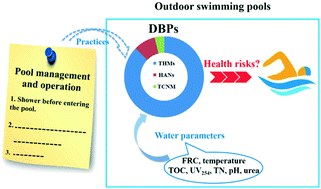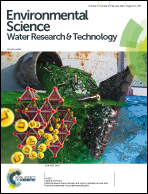Occurrence and factors affecting the formation of trihalomethanes, haloacetonitriles and halonitromethanes in outdoor swimming pools treated with trichloroisocyanuric acid†
Abstract
Swimming pool disinfection by-products (DBPs) have aroused widespread concern in many countries due to their adverse human health effects. In this study, the concentration levels of several kinds of DBPs including trihalomethanes, haloacetonitriles and trichloronitromethane were determined in 35 outdoor swimming pools in Hunan, China. The main water parameters investigated in this study included free residual chlorine, total organic carbon, pH, urea, UV254, total nitrogen and temperature. The management and operation of pools were comprehensively investigated as well. The results showed that the mean concentrations of trihalomethanes, haloacetonitriles and trichloronitromethane in the swimming pools were 21 ± 14 μg L−1, 2.1 ± 1.4 μg L−1 and 0.91 ± 0.51 μg L−1, respectively. Chloroform was the most predominant DBP species detected, and dichloroacetonitrile was the most predominant nitrogenous DBP (N-DBP) species detected. Free residual chlorine and pH might be critical factors in controlling the occurrence of DBPs. Showering before entering the pool could reduce the organic matter from swimmers, and this practice seemed to be an effective way to reduce the formation of DBPs. It is worth noting that urea, as one of the most predominant organic nitrogen compounds in human sweat and urine, had a high concentration in the investigated swimming pool samples. The cancer risks of DBPs in these outdoor swimming pools were lower than the US EPA guidelines in general, while the harm of DBPs couldn't be overlooked at high concentrations.



 Please wait while we load your content...
Please wait while we load your content...